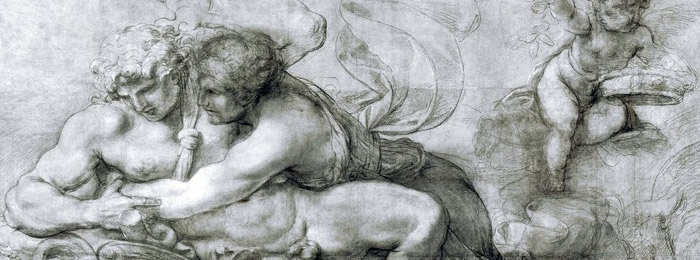Silverpoint Drawing Transfer

Question from Ryan
What is the best method of transferring an outline to a prepared paper for silverpoint?
Dear Ryan,
You are absolutely correct that a drawing has to be transferred to a prepared silverpoint support rather than be drawn directly on the grounded surface. Silverpoint ground should be protected from erasing, re-drawings, and contact with the skin of the hand.
There are various ways to transfer drawings for silverpoint. The one that works the best for me is using tracing paper.
First, do a full-size preparatory drawing in graphite pencil on paper. At this stage, it is easy to make corrections to the composition and alter the proportions, sizes and layout of any objects. You can erase and redraw your sketch as many times as you need.
When you’re happy with the sketch, transfer it onto a piece of tracing paper that is cut to the size of the prepared silverpoint support. Keep in mind that the outlined image will be mirror-reflected if you transfer the image onto the silverpoint ground at this stage.
To keep the original composition without reflection, turn the tracing paper over and outline the drawing in graphite pencil once again. Afterwards, you can turn the tracing paper and erase the first outline. Erasing is optional, but it will help you to see any missing pieces when transferring to a silverpoint ground.
Now you are ready to transfer your drawing onto the prepared silverpoint ground.
Attach the tracing paper to the silverpoint support with a piece of paper tape so the drawing outline is facing the ground. Do not stick the tape to the ground; instead, fold the tracing paper around the back and stick it to the opposite side of the support. This way you will keep the ground clean and un-damaged. Take a well-sharpened H2 pencil and carefully go over all the outlines. During this process, lift the tracing paper often to check marks on the ground; you may need to reduce pencil pressure if the marks are too bold.
Using tracing paper to transfer your image offers several advantages:
- It is very precise, which complements the nature of the silverpoint technique.
- It gives total control over the transfer process; you can lift the tracing paper and check your results as you go along.
- It is reusable. Once you have a piece of tracing paper with an outline, you may use it for multiple copies of a single drawing.
- It is clean and neat. Tracing paper will protect the silverpoint ground from contact with the skin of the hand when transferring a drawing.
Of course, when drawing in metal-point you should keep a clean piece of paper under your hand at all times.
If anyone uses different drawing transfer techniques that are similarly clean, precise, and suitable for silverpoint grounds, please share your knowledge and experience by commenting on this page.
Many thanks,
Vladimir London
Drawing Academy Tutor
- Receive 15 new videos monthly (45 in total)
- Incredible discount – $4,164
- Bonuses - Fine Art eBooks and Videos
- Drawing Academy Diploma of Excellence after course completion in 3 months
- Personal coaching by Drawing Academy Tutors
- Lifetime membership. Free after the 3rd month
- Immediate access to all 45 video lessons
- Incredible discount – $4,198
- Bonuses - Fine Art eBooks and Videos
- Drawing Academy Diploma of Excellence after course completion in 3 months
- Personal coaching by Drawing Academy Tutors
- Lifetime membership. No more payments


Thanks Vladimir for your swift reply I never would have thought of this method of image transfer I will be trying this out soon.